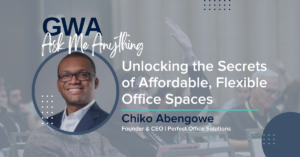“How do build a company culture where everyone wins?” It’s a question that will arise for every coworking space owner and manager—especially new or small spaces. Tracy Wilson, a self-proclaimed child of the coworking industry and HR professional with Pacific Coworking, which has 18 locations in northern California and Reno, Nevada, and partner company Cloud VO, shared her insights on how to build a stellar community, and create a mutually beneficial employer/employee relationship.
Hire people who embody your company culture
On a technical level, Wilson uses Indeed.com to post jobs. She has a lot of great resumes land on her desk thanks to the free platform. However, Wilson also pointed out that stellar credentials and a top-notch cover letter don’t make someone the right fit—and neither does past experience.
“It’s absolutely with my gut instinct,” she said, explaining that while she does tend to go into the hiring process looking for specific skillsets and qualities, hiring decisions often come down to chemistry. She pointed out that while onboarding might be about teaching someone to perform a job, an individual who fits into company culture well tends to be more important.
Help your employees build their future
Wilson also described her company’s unique approach to employee development. Often, their approach to employee relations comes with the knowledge that many employees won’t stay with the company long-term. This perspective causes Wilson to look for employees with a specific interest and skillset, find projects that will allow them to use that skillset to benefit the company, and work with the employee to help those abilities build the employee a platform and portfolio that benefits them as well.
“Have someone using their skills and interest for the benefit of the whole company”
She gave an example of an English major graduate who Wilson assigned to create newsletter templates for space managers—allowing for a company-wide consistency that was sorely needed while also giving the employee excellent portfolio material. In another instance, Wilson said she took a college-student employee from the Cloud VO call center service and had her create a health and wellness corner for the newsletter since this student wanted to work in corporate wellness after graduation.
Encourage freedom and creative expression
“There’s no corporate ladder…it’s really more of a step stool,” Wilson said of their company structure. Aside from a few levels—owner/partner, department heads, community managers, and a few extra levels in the call center—she said they keep bureaucracy to a minimum.
They also allow a lot of freedom for community staff. “We really allow a lot of creativity and location-specific differences to take hold at the center level,” she said. Aside from a general framework and tool usage, community managers have almost complete flexibility in structuring their space. “We really applaud and we really share creativity and how to make the communities within each location thrive, and really have a quality, almost niche feel to them,” she said.
This flexibility, supported by high levels of company transparency, leads into the manager bonuses available for high-performing spaces. These quarterly are tailored based on other factors, including real estate cycles, economic trends, and “the lottery effect,” but they incentivize and empower community managers to build a healthy community in the most effective way possible—not just by “throwing money at it,” Wilson explained.
Give constant feedback
Wilson says their company got rid of the dreaded annual review process altogether, calling it an “outdated construct” predicated on the idea that annual raises and bonuses are based on “showing up for the last 365 days.”
Instead, Wilson’s companies have adopted a year-round review system by keeping careful digital records of employee performance—good and bad—and rewarding employees for innovating and “having [or developing] particular expertise that they bring to the company.”
“We do try to be very proactive,” Wilson stresses.
Create opportunities to connect
The proactive mentality doesn’t just extend to gathering data and feedback on employees. Because their locations are spread out, Wilson says careful, regular communication from management and among staff is critical.
She said they use Whatsapp to communicate regularly, but that she also often spends time on long phone calls with employees, making sure they feel connected and supported enough as they try to tackle problems. They also conduct client surveys twice per year and then communicate about results and necessary improvements with their staff. Departments have weekly, regular meetings that allow remote staff to connect, and quarterly management meetings offer a similar goal. Their fourth quarterly management meeting of the year, Wilson said, is always an in-person, team-building activity held over Columbus Day.
In addition, Wilson said her companies developed monthly webinar series, with at least one (but often more) webinar per month. These webinars not only offer another connection point for remote employees, but they also add to a digital library that functions as a useful resource when onboarding new employees.
Always have a backup plan
For many coworking spaces, especially new and small ones, the problem of covering for an employee who is sick or takes a vacation can bring a lot of stress. Wilson offered several solutions here, but stressed the need to accept that not every absence can be covered—and that’s okay.
“You can’t necessarily staff, in most cases, to have extra and not worry about it from your bottom line,” she said. Wilson mentions that their spaces close between noon and 1 p.m., rather than trying to find someone to cover employee lunch breaks each day. They communicate this arrangement to members and works fine in most cases.
Wilson also recommends partnering with local universities and training college students as substitutes to cover more extended absences—an arrangement she said her company has found very beneficial. She suggests giving certain members basic training on how to cover briefer absences in exchange for a discounted office rate.
Furthermore, she discussed handling issues with chronic absenteeism, extended sick leave, and similar topics, but recommended that each space operator check their state-specific laws on these topics.
This blog post was written in connection to the GWA Coworking Council Series, an ongoing collaboration with coworking experts and leaders to educate and share their expertise during a live virtual event session. Sessions are open to all GWA members, click here to become a member and gain access to future sessions and a library of Coworking Council recordings




